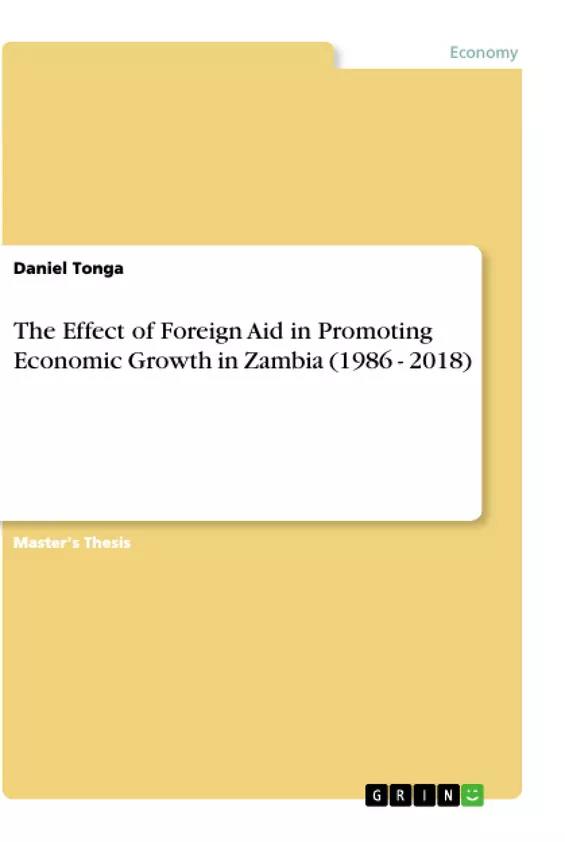This research study has analyzed the effects of foreign aid in promoting economic growth in Zambia. The study used available data in Zambia from 1986 – 2018. The study adopted the ARDL model for investigating the short and long time relationship between foreign aid and Gross Domestic Product GDP. The hypothesis of foreign aid having an effect on economic growth was explored and examined. This study sought to archive the following objectives: To establish whether there is a connection between foreign aid and economic growth in Zambia and determine whether foreign aid significantly contributed to Zambia’s economic growth in the period under review.
For policy implications, this study also analyzed the determinant of economic growth in Zambia over the same period. The results clearly revealed a positive relationship between foreign aid and Zambia’s economic growth in a given period that was under investigation.
The findings in this study affirm that foreign aid may be important in promoting economic growth. This study also asserts that foreign aid may be effective in improving the quality and lives of people if used effectively. Thus, the outcome of this study recommends that foreign aid be directed towards the promotion of investment because its proper use can promote and boots the country’s economic growth.
For policy implications, this study also found that independent variables such as Foreign Direct Investment FDI, Population Growth, Government Expenditure and Consumer Price Index as important and determinants of economic growth in Zambia over the same period.
Thus, this study found that important drivers of economic growth included foreign aid inflow, population growth, investment whilst government expenditure and inflation affected GDP negatively, thus their impact was insignificant and negligible.
This study furthers found efficiency and effectiveness of programs by government supported by foreign aid being effective to promote growth, hence, the reason why it is important for traditional donors to support government in many sectors.
Inhaltsverzeichnis (Table of Contents)
- CHAPTER ONE - INTRODUCTION
- 1.0 Background of the Study
- 1.2 Statement of the Problem
- 1.3 General Research Objective
- 1.3.1 Specific Research Objective
- 1.3.2 Research Questions
- 1.4 Hypothesis Testing….………………………….
- 1.5 Significance of the Study
- 1.6 Limitations and Delimitations.......
- 1.6.1 Limitations
- 1.6.2 Delimitations
- 1.7 Scope Study.
- 1.8 Definition of Variable and Key Terms
- 1.8.1 Economic Growth
- 1.8.2 Foreign Aid
- 1.8.3 Effect
- 1.8.4 Gross Domestic Product
- 1.8.5 Population Growth (PG)
- 1.8.6 Investment (FDI) .....
- 1.8.7 Government Expenditure
- 1.8.8 Inflation
- 9.0 Organization of this Study
- CHAPTER TWO - LITERATURE REVIEW
- 2.0 Introduction of the Literature Review .......
- 2.1 Theoretical Literature
- 2.2 Modernisation Theory
- 2.3 Theory of Economic Growth
- 2.4 Investment in Aid
- 2.4.1 Physical Capital
- 2.4.2 Heath
- 2.4.3 Education
- 2.4.4 Improved Institutions
- 2.5 Empirical Literature.
- 2.6 Forms of Foreign Aid...
- 2.7 Technical Assistance:..\li>
- 2.8 Programme Aid.
- 2.9 Humanitarian Aid
- 2.10 Food Aid:
- 2.11 Theoretical and Conceptual Framework
- 2.11.1 Critique of the Literature
- CHAPTER THREE – METHODOLOGY
- 3.0 Introduction
- 3.1 Model Construction
- 3.2 Research Design.......
- 3.3 Data type and collection procedure.………………………..\li>
- 3.3.1 Diagnostic Tests
- 3.3.2 Stationarity and Non- Stationarity
- 3.3.3 Unity Root Testing
- 3.3.4 Cointegration.
- 3.3.5 Data Analysis Procedure
Zielsetzung und Themenschwerpunkte (Objectives and Key Themes)
This dissertation examines the impact of foreign aid on Zambia's economic growth between 1986 and 2018. The research seeks to analyze the relationship between foreign aid and economic growth, considering various factors that could influence their interaction.
- The role of foreign aid in promoting economic growth
- The impact of different forms of foreign aid on economic growth
- The challenges and limitations of foreign aid in fostering economic development
- The impact of foreign aid on key economic indicators such as GDP growth, investment, and employment
- The importance of effective governance and institutional frameworks in maximizing the benefits of foreign aid
Zusammenfassung der Kapitel (Chapter Summaries)
Chapter One provides an introduction to the study, outlining the background of the research, the problem statement, research objectives, and the significance of the study. It defines key terms and concepts related to foreign aid and economic growth. Chapter Two presents a comprehensive review of relevant literature, examining theoretical frameworks and empirical studies on the impact of foreign aid on economic growth. It explores various theories and concepts related to foreign aid, including the Modernisation Theory, the Theory of Economic Growth, and different forms of foreign aid.
Schlüsselwörter (Keywords)
The dissertation focuses on the relationship between foreign aid and economic growth in Zambia. Key terms include foreign aid, economic growth, gross domestic product, investment, government expenditure, and inflation. The study investigates the impact of different forms of foreign aid, such as technical assistance, programme aid, and humanitarian aid, on economic development in Zambia. The research also explores the importance of institutional factors and good governance in maximizing the benefits of foreign aid.
- Citation du texte
- Daniel Tonga (Auteur), 2019, The Effect of Foreign Aid in Promoting Economic Growth in Zambia (1986 - 2018), Munich, GRIN Verlag, https://www.grin.com/document/507871



